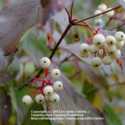
By Newyorkrita | Many of us put seed out to attract backyard birds, but we can bring even more birds to the garden by adding summer fruiting shrubs.
|
awesomeblossom said:Make sure your Felines ( Kitty Cats) don't kill the very same songbirds you attract!
They are Burderers!
hampartsum said:Hello Rita, do you have any cotoneasters in your garden?. I have six different species, ..(.I'm having difficulties in Identifying the species in the data base, although mine are each quite distinct). A few are evergreen, but most are deciduous and have lovely autumm colors with standing crops of red berries that are cherished by my owerwintering families of thrushes. They seem to hop from one bush to the other., all during winter. Since the red berries are long standing they shine out during snow covered moments. Other wintering birds also stop by to the cotoneasters. The thrushes' droppings aid the germination of the seed so some species ( three of mine) are definitely bird dispersed. I have seedling bushes growing nearby , under trees where birds fly for cover . One species is the herringbone cotoneaster ( Cotoneaster horizontalis). Another is a fairly tall species with scented flowers soon in late spring. It has reddish berries that droop in clusters and turn purple as they ripen. This species is particularly easy to propagate with bird droppings. Once you have a single specimen then eventually you will have many. It has beautifull red fall leaf color.